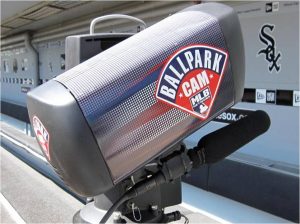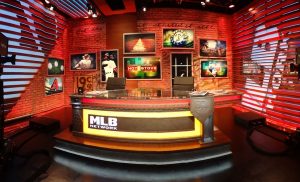MLB Returns: Wearing Two Production Hats, MLB Network Deploys Full At-Home Model, Provides RSN Infrastructure
The well-known NTT Ballpark Cam will be used in live game coverage, instead of standalone interviews
Story Highlights
When the Cincinnati Reds take the field in Great American Ball Park at 6 p.m. ET tonight, it’ll mark the latest Opening Day game in the 11-year history of MLB Network. As the players continue to shake off the rust of their four-month downtime, MLB Network is ready to roll on multiple fronts, deploying a full at-home production model in Secaucus, NJ, and, more important, supplying all the regional sports networks with the foundation to capture a clean feed used by all the national broadcasters.
“[The delay to the start of the season] was an unfortunate situation, but we’ve found ways to do things that we never thought we could because the technology has been amazing,” says David Patterson, SVP, production, MLB Network. “When everybody starts from yes, that makes it really, really easy, and it has been a team effort.”
Strategy in Secaucus: Spaced-Out Facility, Game Creek RiverHawk House Offsite Team
Aside from studio programming and other baseball-centric content, MLB Network’s bread and butter is its Showcase schedule of games. Seven contests will be played within the first 10 days of the shortened season. Because MLB is allowing only one network and its staff onsite, the facility in Northern New Jersey will play an invaluable part this large-scale effort, housing on-air, production, and operations staff.
“We have Game Creek RiverHawk outside in our parking lot,” says Susan Stone, SVP, operations and engineering, MLB Network. “Over the past two weeks, our engineering team had 33 projects to get to before Opening Day, one of which was to put a BSP [broadcast service panel] outside one of our buildings for our Showcase truck. We’re trying to make it into PC4, or a fourth production-control room.”
At a basic level, production crews will be dispersed and socially distanced in three separate control rooms. In addition to the mobile production, other ancillary areas that normally serve as common workspaces are being recruited to adhere to stringent health and safety guidelines. For example, conference rooms will be divided into individual sections for a handful of researchers.
“We had a space called Flex One, which was for overflow edit, and now we have Flex Two, which we’re using like our B unit for Showcase with our graphics team up there,” Stone adds. “We’ve been able to reduce the number of people in the truck by 50%, which we’ve had to do in all of our control rooms.”
The graphics team will be working with a graphics package similar to that used in recent seasons, including sabermetrics and other digestible data through Statcast. After the initial barrage of games, the team will reassess and mull over possible graphics enhancements, including fan integration.
“After this first weekend, we’ll have a good indication of where we stand,” says Patterson. “We’ve got four games in a row, so we should have a good indication of what’s working and what’s not working.”
On-air talent Scott Braun, John Smoltz, Stephen Nelson, and Tom Verducci will be located in Studio K, regularly reserved for shows like High Heat with Christopher “Mad Dog” Russo and Hot Stove. The only talent onsite will be sideline reporter Jon Morosi in Cincinnati and in St. Louis the following day.
Leveraging Resources: NTT Ballpark Cam, Multiple Fiber Paths for RSNs
Live production is hard enough in the current circumstances, but, when you’re also responsible for supplying a good chunk of what will make this season viewable by the masses, it becomes a herculean achievement. Through constant collaboration in a joint project with the league’s infrastructure team, the operations team developed a thorough plan that will be at the core of the RSN framework.
“We have a pretty developed network between the ballparks and also ballpark to ballpark,” says Stone. “We were able to strategically decide how we would use our encoders and decoders in the ballpark to get what the league needs for all of their media entities, archives, and international partners. We also thought we could work around and spare some equipment that can be used by the RSNs to send feeds from the home ballparks to the away ballparks.”
Diving deeper into the borrowed technology, the RSN layout will include five fiber paths that will create an intricate web of transmission, two cameras controlled solely from Secaucus, and additional support via flypacks to prevent congestion when MLB Network enters the pool of resources.
One essential piece of hardware that will remain onsite is the coveted NTT Ballpark Cam. Typically nestled in one of the dugouts, the robotic camera is used for onsite pregame reporting and player interviews conducted by Intentional Talk. This year, however, it will get some in-game action with the assistance of a camera operator since fans won’t be in attendance.
“We’re using it for reaction shots and could get some great reacts from teams in the dugouts that we normally might not get,” says Patterson. “I think it’s definitely advantageous.”
Reimagined Philosophies: New Approach Features Slower Pace, Extra Communication
On the production end, this season will call for a change in production philosophies. Because a world-feed style of production is usually reserved for a World Cup or an Olympics, this is foreign territory for folks on the baseball side of many networks. For MLB Network and, more notably, Senior Coordinating Producer Chris Pfeiffer, it’ll be a bit of a broadcasting curveball.
“It makes things a little more complicated,” he explains. “We’ve been holding a lot of meetings over the last couple of weeks with the RSNs about the importance of neutral coverage and covering what’s on the field. They can’t get too specific with their cuts since it may it hurt everybody taking the feed. [For example], if they cut to a championship [banner] up on the wall at the stadium, everybody has to react to it.”
Although a majority of staffers are situated in one spot (excluding the outdoor truck), extensive internal communication and taking a telecast at a slower pace are two elements of a live production in this era.
“We’ve talked a lot about the importance of over-communicating, so we have a hot mic on the director and an associate director in the truck that’s dedicated to tipping us off on things that might be happening so we can beat what [the local RSN] is doing to get to our camera,” continues Pfeiffer. “There are a lot of things that are set up to protect the feed, but you just have to go a little bit slower. I told [my crew] that, even though we’ve been together for a while, this is a different way to go about doing a game, so don’t take anything for granted. If we’re all pulling in the same direction, it’ll work.”
Along with visual cues, directors and producers will have to find ways to incorporate the fabricated crowd noise generated by the audio of Sony’s MLB the Show. According to Patterson, it’s something that the crew, and fans watching at home, will eventually get used to.
“I think it’s a work in progress,” he says. “After you watch for a few minutes, it’s kind of like the [traditional] scorebug. When you watch old games, it’s like, “Wow, where’s the scorebug? I’m used to seeing it.” Fans will definitely get used to having it in the background.”
Practice Makes Perfect: 2020 MLB Draft Gives Crew Some Remote Production Reps
Nearly a month and a half ago, the MLB Network team embarked on one of the first in-person productions since the sports shutdown. The 2020 MLB Draft was a massive undertaking, with balancing 120 in-home feeds the biggest challenge. Prior to one of the more high-profile productions done during the COVID-19 pandemic, the telecast would be an unfamiliar concept, but now, with this multi-day show on the schedule, the network has a few more answers.
“We’re certainly leveraging a lot of what we learned, because, in this day and age, most of our correspondents who would be on the field doing reports from the NTT Ballpark Cam can’t do that,” says Stone. “With the setups that we had with the iPhones, ring lights, and accessory kits, we’ve been deploying them to a bunch of our correspondents so they can do reports for us from areas like the concourse. We’ve figured out a new way to have a presence while still protecting everybody’s health and safety.”
Since Draft coverage also used a lot of editing support from staff in their respective residences, more than 50 licenses for remote-editing software will be in use for all Showcase games this year.
Not How You Start, But How You Finish: Set for 60-Game Dash
The smorgasbord of MLB games is tantalizing for fans who have been waiting since Oct. 30, 2019, the last time a professional baseball was thrown. For network personnel, working around colleagues again will be welcome.
“We’re used to doing Zoom calls all day,” says Patterson, “but seeing people is going to be really amazing. In the last week, we’ve started a countdown, so we’ll be camped out in the parking lot and ready to go.”
The work done when no one is watching is the basis for success, and, like the athletes on the field, MLB Network has prepared diligently and well for this peculiar season.
“I’m really proud of both our operations and engineering teams and how they’ve reacted to the circumstances,” says Stone. “They have been extremely creative and innovative to keep us on the air for all of these months when everybody was out of the building. Production has also been a part of the solution, but being adaptable with the ideas that we created to stay on the air is really the silver lining of this tough situation.”
Through the weekend, MLB Network Showcase will highlight a few teams across the nation, including Pittsburgh Pirates and St. Louis Cardinals (July 25 at 2 p.m.); Los Angeles Angels and Oakland Athletics (July 26 at 4 p.m. and July 27 at 3:30 p.m.); Arizona Diamondbacks and Texas Rangers (July 29 at 4 p.m.); Boston Red Sox and New York Yankees (July 31 at 7 p.m.); and Los Angeles Dodgers and Diamondbacks (Aug. 2 at 4 p.m.).
Check out all of SVG’s ‘MLB Returns’ coverage:
- RSNs Take Over World Feed for All MLB Broadcasts, Customize for In-Market Fans
- ESPN Preps Normal Sunday Night Baseball Graphics Package for ‘Enhanced World Feed’
- Wearing Two Production Hats, MLB Network Deploys Full At-Home Model, Provides RSN Infrastructure
- Baseball Has Its Crowds on an iPad With Artificial Fan Noise
- As RSNs Handle World Feeds, Sinclair’s Fox Sports RSNs Shoulder Production Load
- NBC Sports Regional Networks Seeks Balance Between World Feed and Serving In-Market Fans
- NESN To Produce ‘Red Sox-ized’ In-Market Broadcasts in Addition to World Feed
- AT&T SportsNet RSNs Use Mix of Studio, Mobile Facilities for World Feed, In-Market Productions
- MASN Tested Early With Back-to-Back-to-Back World Feeds for National Broadcasts
- Fox Sports Augments MLB on Fox Telecasts With Virtual Fans
- …and stay tuned for more next week!


